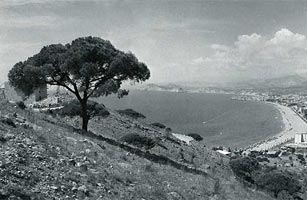
Levante Beach: The tiny fishing village of Benidorm had few assets — two sandy beaches and lots of sun. Today, it hosts more than 5 million visitors per year
The most direct way to drive from Berlin to Paris is to follow the same route that Soviet tanks would have taken during the cold war — head west across the north German plain to Hanover, the Ruhr and Ardennes, then rumble through the beet and wheat fields of northern France. Load up with caffeine, put your foot to the floor on Europe's magnificent highways, and you might do the whole trip in a long day.
That seemed too dull and too easy. I was born in the U.K. in 1951, and — like many of my generation — grew up making no distinction between being European and being British. But I'd never really tried to get the measure of how the Continent has changed in 50 years. I wanted to see whether "old" Europe — the nations that had been liberal democracies in 1953 — and "new" Europe — those which, for two generations, had been ruled by communist regimes — were managing to find a common sense of thought and outlook. It seemed a good time to take a look; Europe's bitter row over the war in Iraq and its collective yawn over the proposed new E.U. constitution suggest that European unity is still a concept more of hope than of reality. I wanted to track forces more fundamental than those wielded by politicians and bureaucrats. So from Berlin I turned south, and took a week driving through Germany, the Czech Republic and France before I arrived in the City of Lights just in time to celebrate the quatorze juillet. We'll get to the celebrations later.
The route was deliberate. There are many Europes, but as Ian Buruma once argued, a fundamental division lies between the Europe of the littoral — the seafaring lands of Britain, the Netherlands, Atlantic France and the Hansa cities, largely Protestant, outward-looking, adventurous, with the world on their doorstep — and the Europe of the interior — Catholic, self-absorbed, whose trade went by land rather than sea, and where connections to overseas empires are of less moment than the memories of old political units like Brandenburg, Saxony, Bohemia, Franconia, the Palatinate, Alsace and Lorraine. On the littoral, the revolutionary effect of four centuries of globalization makes it hard to identify what is European about a culture and what is international. I wanted to test the heartland.
It is obvious that Europe has changed in the last two generations. It is richer, more free, less deferential. But it will take more than 50 years for the Continent to shake off the grasp of its recent history. On the outskirts of Nuremberg, you can see the ruins of the grounds where the Nazis held their party rallies in the 1930s. In a new museum and documentation center there, Eckart Dietzfelbinger, who directs the center's research, described Europe as a society living "in the shadow of the past." That's true; but it is also a society with a cautious optimism about the future. Europe, old and new, wants to believe that the gains that have been won since 1945 and 1989 — those two dates of equal liberation — are safe, and that the qualities of life which Europeans have sought for generations have now been secured.
Why is the past so vividly present in modern Europe? I think there are three reasons. First, the horrors of the long European war from 1914 to 1989 were so pervasive and so foul that there is no escaping them. In Berlin, the Soviet brutalist architecture along Karl-Marx-Allee (originally Stalinallee) reminds you that the city had to be rebuilt from dust and splinters. The great gaps in the skyline of Dresden, a city that, when crammed with refugees, was needlessly destroyed by the Allies in February 1945, tell the same story. "Dresden was a war crime," the German novelist Günter Grass said to me earlier this year. He's right. We've all been moved by the pathos of war memorials, in Flanders, say, or on the cliffs above the Normandy beaches. But — never having been there before — I broke down in tears at the Ossuary at Verdun, where the remains of 130,000 bodies blown to smithereens in World War I are interred. You can peer through glass at the heaps of bones, tipped together in a sacred helplessness, as if those who survived the slaughter were saying, "We know it's not much, but we did our best." When French President François Mitterand and German Chancellor Helmut Kohl stood in front of the Ossuary and held hands in 1984, their gesture was not just one of reconciliation, but of a shared and irremovable pain.
Second, for those who lived east of the Iron Curtain, "the war" ended not in 1945 but in 1989. It is only in the last decade that they have been able to speak, and perhaps think, honestly and openly about their lives. In Berlin I met Karl-Heinz Gebhardt, who, as a 24-year-old carpenter in 1953, left a construction site on the Stalinallee to join a march through Berlin. Workers, with arms linked, walked into the heart of the city, through lines of police and soldiers. Though some on the marches called for free elections, Gebhardt insists he wasn't political; he joined the march, he says, because the East German authorities had cut wages and raised prices. But when he went back home at the end of the demonstrations — which were crushed by Soviet troops and T-34 tanks — he vowed to himself that he would never talk about them until he was 65.